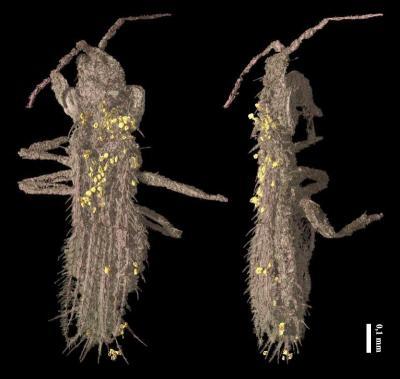Amber from Cretaceous deposits 110-105 million years ago in Northern Spain has recorded this first ever record of insect pollination. In two pieces of amber, researchers found several specimens of tiny insects covered with pollen grains, revealing the first record of pollen transport and social behavior in this group of animals.
Today, more than 80% of plant species rely on insects to transport pollen from male to female flower parts. Pollination is best known in flowering plants but also exists in so-called gymnosperms, seed-producing plants like conifers. Although the most popular group of pollinator insects are bees and butterflies, a myriad of lesser-known species of flies, beetles or thrips have co-evolved with plants, transporting pollen and in return for this effort being rewarded with food.
During the last 20 years, amber from the Lower Cretaceous found in the Basque country in Northern Spain has revealed many new plant and animal species, mainly insects. Here, the amber featured inclusions of thrips that feed on pollen and other plant tissues. They are efficient pollinators for several species of flowering plants.

Synchrotron tomography image of the specimen of Gymnospollisthrips minor studied at the ESRF. The pollen grains are highlighted in yellow. Credit: ESRF
Two amber pieces revealed six fossilized specimens of female thrips with hundreds of pollen grains attached to their bodies. Their highly specialized hairs are very similar to the ones of well known pollinators like domestic bees. The scientists describe these six specimens in a new genus (Gymnopollisthrips) comprising two new species, G. minor and G. major.
The most representative specimen was also studied with synchrotron X-ray tomography at the European Synchrotron Radiation Facility to reveal in three dimensions and at very high resolution the pollen grain distribution over the insect's body.
The pollen grains are very small and exhibit the adherent features needed so that insects can transport them. The scientists conclude that this pollen is from a kind of cycad or ginkgo tree, a kind of living fossil of which only a few species are known to science. Ginkgos trees are either male or female, and male trees produce small pollen cones whereas female trees bear ovules at the end of stalks which develop into seeds after pollination.
Only amber can preserve behavioural features like pollination in such rich detail over millions of years. 100 million years ago, flowering plants started to diversify enormously, eventually replacing conifers as the dominant species.
"This is the oldest direct evidence for pollination, and the only one from the age of the dinosaurs. The co-evolution of flowering plants and insects, thanks to pollination, is a great evolutionary success story. It began about 100 million years ago, when this piece of amber fossil was produced by resin dropping from a tree, which today is the oldest fossil record of pollinating insects. Thrips might indeed turn out to be one of the first pollinator groups in geological history, long before evolution turned some of them into flower pollinators," concludes Carmen Soriano, who led the investigation of the amber pieces with X-ray tomography at the ESRF.
Published in the Proceedings of the National Academy of Sciences (PNAS).




Comments